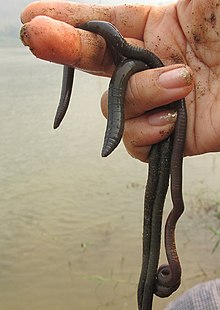|
Amynthas mekongianus
Amynthas mekongianus, the Mekong worm or Mekong giant earthworm, previously known as Megascolex mekongianus, is a species of earthworm in the family Megascolecidae. It is native to the vicinity of the River Mekong in southeastern Asia and may have more than 500 segments and grow to a length of 2.9 m (10 ft).[1] DescriptionThe Mekong giant earthworm may grow to a length of up to 2.9 m (10 ft).[2] Compared to their great length, these worms are relatively slender.[3] The type specimen was one metre long and 8 mm (0.3 in) wide at the broadest point (segment 5). It had 370 segments and was a greyish colour, rather paler on the ventral surface. The prostomium was poorly preserved. The second segment had 46 setae (bristles) in an incomplete ring with a gap on the ventral surface. Segments 3 to 25 bore about 100 setae each, arranged in a complete ring. The male pores were on segment 17, but this specimen was immature and lacked a clitellum.[1] Distribution and habitatThe type specimen was recorded as being from "Ban Leum on Mekong River, Annam". This was mistakenly believed to refer to a village in Central Vietnam well away from the River Mekong, but it has been found that "Ban leum" means "[I] forget the place" in the local dialect, and the type locality is thought to be in Thailand or Laos. The river forms a delta at that point and contains extensive mud and sand flats and embankments where the worms live. Pigs forage and fishermen dig worms for bait there.[1] EcologyUnlike most other species of giant earthworm, which generally inhabit pastureland, the Mekong worm burrows into the muddy banks of the River Mekong in Laos.[2] The worm forms complex networks of tunnels and brings large quantities of ingested soil to the surface in the form of worm castings.[4] The worms may be collected from the mud, but are more easily collected from underwater at depths around 40 cm (16 in). Little is known of the worm's ecology.[1] References
|
||||||||||||||||||||||||||||||||||
